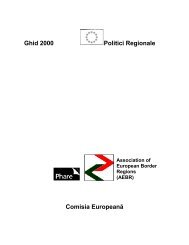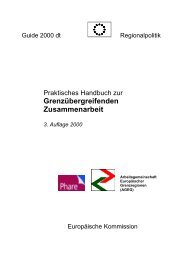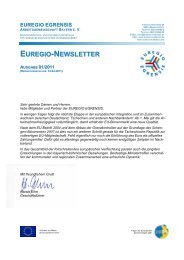GREEN PAPER - Association of European Border Regions
GREEN PAPER - Association of European Border Regions
GREEN PAPER - Association of European Border Regions
Create successful ePaper yourself
Turn your PDF publications into a flip-book with our unique Google optimized e-Paper software.
2. Possible options for further TENT-T development<br />
The Commission considers three options for further TEN-T development to be<br />
possible:<br />
(1) Maintaining the current dual layer structure with the comprehensive<br />
network and (unconnected) priority projects,<br />
(2) Reducing the TEN-T to a single layer (priority projects, possibly connected<br />
into a priority network),<br />
(3) Dual layer structure with the comprehensive network and a core network,<br />
comprising a – geographically defined – priority network and a conceptual<br />
pillar to help integrate the various transport policy and transport<br />
infrastructure aspects.<br />
3. Statement <strong>of</strong> the AEBR on the structural options on the creation <strong>of</strong> TEN-T<br />
Option 1 with dual layer: Comprehensive network and priority projects: The current<br />
structure <strong>of</strong> TEN-T policy should not be pursued. The disadvantage <strong>of</strong> lack <strong>of</strong><br />
influence <strong>of</strong> the EU on the due-process and entire completion as well as the insufficient<br />
effect <strong>of</strong> the network is too serious. The advantages can be further realised with option<br />
3.<br />
Option 2 with one new layer: Priority projects - possibly in extended form: The<br />
concentration on the main community instruments is a progress. Within the priority<br />
projects (core network) this would result in reviewable and verifiable improvements for<br />
border and cross-border areas.<br />
The lacking influence on the comprehensive network with additional political<br />
transport functions is a decisive disadvantage, especially as the EU-level would no<br />
longer take care <strong>of</strong> intersections, gateways, cross-border links, hinterland connections<br />
and accessibility <strong>of</strong> ports and airports in border areas not belonging to priority<br />
measures.<br />
Option 3: Dual layer with a comprehensive network and a "core network“: The whole<br />
<strong>European</strong> transport network with all carriers and transport management systems will<br />
remain in the political field <strong>of</strong> action <strong>of</strong> the EU. At the same time priority projects can<br />
create considerable advantages by the scheduled core network with a geographical<br />
pillar (deduced from the present constellation <strong>of</strong> priority projects) and a conceptual pillar<br />
(to determine further projects on the basis <strong>of</strong> common criteria). Especially, the EU can<br />
connect the core network and comprehensive network. This will guarantee a better<br />
concentration on the priorities.<br />
All border and cross- border areas will stay in the focus <strong>of</strong> the EU-policy and<br />
possible measures. Even peripheral areas and their access and opening for airports,<br />
ports and cross-border secondary networks in connection with the primary networks will<br />
remain under their political monitoring.<br />
Disadvantages like lack <strong>of</strong> funds and “uncertain” factors in the TEN planning are not so<br />
severe. Even today there is a lack <strong>of</strong> funds, also on EU-level, so that the main<br />
responsibility remains to the national member states. Plans are always related with<br />
“uncertain” factors.<br />
AGEG/AEBR/ARFE / Enscheder Str. 362 / D-48599 Gronau / Tel.: 0049 2562 70219 / Fax: 0049 2562 70259<br />
info@aebr.eu / www.aebr.eu<br />
3








